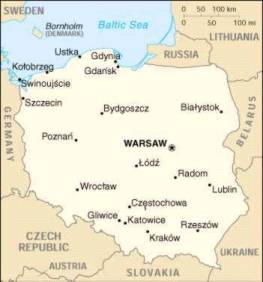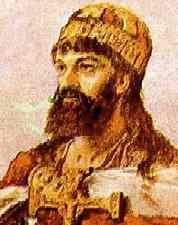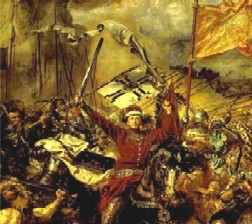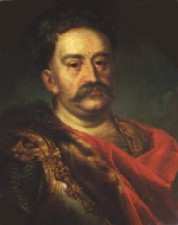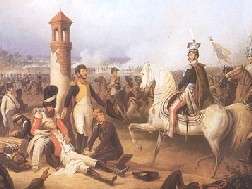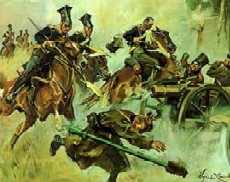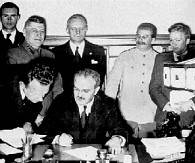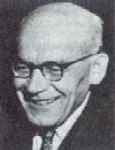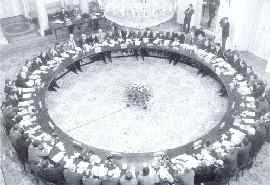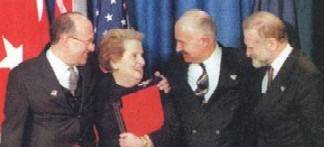Poland
 Flag of Poland | |
| Capital | Warsaw |
| Inhabitants | 38.186.860 |
| Language(s) | Polish |
Poland is a large central European nation that borders on the Baltic Sea. Warsaw is Poland's capital and largest city.
Poland is named after the Polane, a Slavic tribe that lived more than a thousand years ago in what is now Poland. The name Polane comes from a Slavic word that means plain or field. Flat plains and gently rolling hills cover most of the country. Rugged mountains form part of the southern boundary of Poland, and thousands of small, scenic lakes dot the northern regions of the country.
Poland gained its independence in 1918 only to be overrun by Germany and the Soviet Union in World War II. It became a Soviet satellite country following the war, but one that was comparatively tolerant and progressive. Labor turmoil in 1980 led to the formation of the independent trade union "Solidarity" that over time became a political force and by 1990 had swept parliamentary elections and the presidency. A "shock therapy" program during the early 1990s enabled the country to transform its economy into one of the most robust in Central Europe, boosting hopes for acceptance to the EU. Poland joined the NATO alliance in 1999.
History
While Poles trace their roots to prehistoric times, as a nation, present-day Poland dates its real origins to the year 966, when the foundation of Polish statehood was laid. That was the year when Mieszko I, the first historical representative of the old Polish Piast dynasty, accepted Christianity from the south. He is the first member of the gallery of Polish Kings in spite of the fact that only his son, Boleslaw Chrobry - Boleslaw the Brave - was the first ruler to be actually crowned.
In Poland's lengthy and tumultuous history, its Golden Age, which flourished under the last two kings of the Jagiellonian dynasty, deserves special attention. This was a time rich in art, poetry, religious experience, scientific advances and economic prosperity. It inspired astronomer Nicholas Copernicus to assign Earth a new place in the solar system and moved Wit Stwosz to create his unsurpassed altarpiece, which can still be admired in Krakow's St. Mary's Church to this very day. In Krakow, the Royal Castle on Wawel Hill was converted into a splendid Renaissance residence, while a handsome fortress city went up in Zamosc.
Between 1795 and 1918, Poland disappeared from Europe's maps, to re-emerge once more independent and proud at the end of World War I. The Nazi conquest of 1939, another war and four decades of Communist rule could not vanquish the indomitable and tenacious Polish spirit.
The origins: Acceptance of Christianity - 966
The true origins of Poland have been lost in the mists of time, but a number of popular legends tell of the country's beginnings. Among them is the tale of three brothers, Lech, Czech and Rus, each of whom set in a different direction to make his own way in the world. Lech went to the west. As he came to a clearing in a forest, he noticed a nest of a white eagle. Lech decided to settle there with his people. He named the place Gniezno (nest) while his people became known as Polanie, which means "field dwellers".
The eagle became a symbol of his tribe. To this day a white eagle against a red background is the official emblem of Poland. In the beginning of the 10th century the borders of the Holy Roman Empire reached the Odra river . Here the Empire's eastward colonization encountered a powerful obstacle, the well organized state of Polanie who, unknown to Christian Europe, had been developing an autonomous Slavic culture for about 200 years. For several generations the Polanie, under the leadership of the Piast dynasty, withstood armies of the Empire. Rather than succumb to the Empire's eastward expansion, in 966 prince Mieszko accepted Christianity from the Czech royal court and married a Czech princess, Dobrawa. This act had tremendous political consequences. Succeeding generations of Poles recognized this date as the birth of Poland. Once liberated from the darkness of paganism, Poland officially appeared on the map of Christian Europe.
The birth of a kingdom: Coronation of Boleslaw the Brave - 1025
In 997 Brother Adalbert, sent by Mieszko's son and successor Boleslaw the Brave to convert the pagan Prussian tribe, was murdered by the Prussians in a place near present day city of Gdansk. According to a legend, Prince Boleslaw purchased the martyr's body for its weight in gold and brought it back to Gniezno for burial. Upon Adalbert's subsequent canonization, his grave became a holy site. In the year 1000, Holy Roman Emperor Otto III made a pilgrimage to Gniezno. In his presence, a Gniezno archdiocese was established, responsible directly to Rome and not to the German archbishops across the Odra River. Otto also proclaimed Boleslaw as "a brother and aide in the Empire", implying no subordinate relationship. Unfortunately, Otto's ideal of peaceful eastern borders of the Empire came to an end with his premature death. Facing the encroachments of German feudal lords and the new German Emperor on Poland's western frontiers, Boleslaw attempted to unite the Poles, Czechs, and Slovaks into one large state to meet the threat to the western Slavic tribes. However, the Czech and Slovak lands came only briefly under his rule. Boleslaw also warred in the east, and managed to assist in installing a friendly ruler in Kievan Rus. It is said that the great coronation sword of the Polish kings, Szczerbiec ("notched sword"), was then given its name. To attest to his victory, Boleslaw repeatedly struck his sword against the bars of the Golden Gate of Kiev.
Throughout his life, Boleslaw implored Rome for a royal crown. In 1025, near the end of his life, Boleslaw was crowned King of Poland, with the Pope's blessing but without the German Emperor's approval. This was an important step towards the recognition of Poland as a true kingdom within Latin Christendom.
Regional division: Battle of Legnica - 1241
After the death of Boleslaw the Brave, Poland faced a time of chaos, despite the occasional energetic leaders like the controversial Boleslaw II the Bold (ruled 1058-1079), and Boleslaw III the Wrymouthed (ruled 1102-1138), renowned for fighting off German invasions and injecting strong leadership into national life. In a development characteristic of feudalism, the earlier stronger monarchy disintegrated into a number of regional states, ruled by local Piast princes. During this period, the city of Cracow became increasingly important, and possession of that city was deemed necessary for assuming rule over the whole country. Another possible center for the reunification of Poland was the region of Silesia, under their local Piast branch. Unfortunately, Henry II the Pious (ruled 1238-1241) died with virtually all of his knights at the fateful baffle of Legnica facing the Mongol (Tartar) incursion into Europe. Virtually all of Poland was savagely devastated, and the Ruthenian principalities fell under Tartar bondage.
This period also saw one of the most fateful events in Polish history in 1226, when a regional Prince, Conrad of Masovia, invited the German Crusading Order of Teutonic Knights to Poland. He gave them a small area in the north-east in exchange for protection from raids by pagan Prussians. By 1288, the Teutonic Knights had conquered the Prussians and had installed themselves in the area, posing a permanent threat to all of Poland.
Reunified kingdom - 1320
The regional fragmentation of Poland could not have gone on much longer without severe detriment to the country as a whole. Faced by powerful enemies from many sides, king Wladyslaw Lokietek (the Elbow-High), through an incredible effort and persistence, managed to bring the core of the state together with Krakow as its new capital. The cost of this success was loss of Silesia and Pomerania, which had slipped from Polish rule.
Lokietek's major achievement was undoubtedly obtaining the Pope's approval for his appointment as monarch of the reunited realm. Lokietek received the full royal title of Rex Poloniae, with the kingdom named Corona Regni Poloniae, a concept that would achieve a rich tradition and judicial history.
Lokietek's second greatest achievement was the direction of Teutonic conquest. With the support of the German Empire and the Papacy, the Teutonic Order had conquered lands from Gdansk (renamed Danzig), all the way to the northern country of Estonia. When their attention turned to the south, Lokietek's forces dealt them a defeat in the Battle of Plowce in 1331, bringing the conflict to a standstill. The Teutonic Knights then menaced Lithuania, one of the last pagan countries in Europe and, in defense, Lithuanians turned to the east, bringing virtually all of present day Belarus and Ukraine into the Polish sphere of influence.
Great days of Krakow - 1364
Lokietek's son, Casimir III, was born in 1310 and was the only Polish king distinguished as "Great". His reign laid the foundation for future Polish grandeur. Casimir was a king of all the people, called "King of the Peasants" for his attempt to secure the authority of royal courts over aristocratic abuses and to codify Polish law. It is said that "he found Poland built of wood and left her built of stone." His ambitious projects ringed the country with fortifications. He stimulated trade and welcomed Jews to Poland at a time when they were persecuted in virtually all other European countries. This is when the Jewish quarter of Krakow was founded and named Kazimierz to honor the king. On the diplomatic front, he concluded treaties with the Teutonic Order and Bohemia. Even though this meant abandoning Pomerania and Silesia, at least for a time, Casimir added large areas to the Polish Kingdom, pushing the country's borders south-east. He re-founded the Ruthenian settlement named after Prince Lew, calling it by its modern name, Lwow.
The years 1363-1364, known as "The Great Days of Krakow," saw the founding of Poland's first university, called the Cracow Academy, and Casimir presiding over the marriage of his granddaughter to a future German Emperor. At this occasion kings and princes from all over Europe, including the Emperor himself, visited the city and discussed matters of international politics. The wedding banquet, recorded by French poet Guillaume de Marchaud, took place at the Market Square home of merchant Mikolaj Wierzynek. Today, visitors to Krakow can visit that same house and dine in one of Poland's finest and, most likely, oldest restaurants. To Poland's sorrow, Casimir died without producing a legitimate heir and his death effectively ended the Piast dynasty.
Advent of Jagiellonian dynasty: Crowning of Wladyslaw Jagiello - 1386
The war over Casimir's succession broke up even before his death in 1370. Finally, in exchange for a set of privileges, the warring parties agreed to crown his nephew, Louis the Hungarian of the d'Anjou dynasty. The privileges, known as Kosice Statutes, limited the obligations imposed on the Polish nobility.
Although Louis' rule was brief, it had tremendous consequences for the subsequent character of the Polish state. The political power was given to the nobility at the time when in the west a reverse process was taking place. During his reign, Louis amassed one of the largest dynastic regimes of his time. Since at the time of his death, he left
only two young daughters as heirs, the war of succession erupted again. The younger daughter, Jadwiga, was finally proclaimed Queen of Poland in 1385, at the age of 11 years. A marriage with Jogaila, the Lithuanian ruler was proposed to cement an alliance with Poland's powerful eastern neighbor. At the Union of Krewo in 1385, Jogaila agreed that in exchange for Jadwiga's hand he would convert to Christianity, coordinate operations against the Teutonic Knights and associate Lithuania (which then included most of present day Belarus and Ukraine) with the kingdom of Poland in a permanent union. Jogaila, known as Jagiello, was crowned as King of Poland in February of 1386 at an assembly of Polish barons and nobility and adopted the name of Wladyslaw II.
For Jadwiga, the marriage came at the cost of personal happiness. She had been betrothed in infancy to a Hapsburg prince, with whom she was deeply in love, while Jagiello was much older and uncivilized. For reasons of state, however, she agreed to the marriage, and for personal satisfaction, she turned to a life of charitable works. During her reign, she gave all her jewelry and regalia to rescue the financially troubled Krakow Academy and, according to a legend, used a wooden gold-painted scepter for official functions. She died in 1399, at the age of 24. Soon after her death, Jadwiga was declared a saint. In 19th century, to honor its benefactor, tha Krakow Academy was renamed the Jagiellonian University.
Wars with Teutonic order: Battle of Grunwald - 1410
With the dynastic union of Poland and Lithuania assuming a more permanent nature, as well as the conversion of Lithuania to Christianity, the Teutonic Order was faced by a powerful new coalition. Nevertheless, the Order continued to command enormous resources and prestige. The situation continued to ferment until 1409, when an open conflict erupted.
On July 15, 1410 a decisive battle, one of the biggest in the history of Middle Ages, permanently weakened the Teutonic Order. The two opposing armies met outside the village of Grunwald (also known as Tannenberg). On one side were the Teutonic Knights, with Western European mercenaries, supported by infantry and cannon, about 27,000 men in total commanded by Grand Master Ulrich von Jungingen. On the other was a larger Polish-Lithuanian-Ruthenian army, supported by Czech and vassal Tartar contingents, of about 39,000 men, commanded by king Wladyslaw Jagiello himself.
The battle lasted for several hours. King Jagiello, unlike his opponent, did not lead the army to battle, but coordinated the efforts from the nearby hill. The Polish and Lithuanian forces were instead led by king's brother Witold, Grand Duke of Lithuania. By the end of the day, eight thousand Teutonic Knights were slain, including the Grand Master of the Order, and fourteen thousand prisoners were taken for ransom. Despite this staggering defeat, the Teutonic Order showed an incredible resilience, falling back on the impregnable fortifications of the Marienburg (Malbork) in the north. Jagiello, lacking proper siege equipment, could not carry the war to complete victory. The First Treaty of Torun in 1411 actually restored the territorial status quo.
The situation remained unresolved until the Thirteen Years War of 1454-1466. Using professional mercenaries and new siege methods, the Poles and Lithuanians finally managed to humble the Teutonic Order. The area known as Royal Prussia (the land along the Vistula up to Gdansk) was incorporated into the kingdom of Poland. The land that eventually became East Prussia remained in the possession of the Order as a vassal state of Poland.
The Battle of Grunwald remains one of the most glorious days in Polish history. The period of struggle in the early 1400s was immortalized by Henryk Sienkiewicz in his historical novel "The Teutonic Knights."
Prussian homage - 1525
The late 15th century and early 16th century marked the height of the Jagiellonian dynasty. Jagiellonian rulers for a time reigned simultaneously in Poland, Lithuania, Bohemia, and Hungary. Unfortunately, the Jagiellonians failed to elaborate a coherent political rationale for organizing the lands between Russia and Germany into a loose federation, in order to prevent their falling under the domain of one of these powers. The situation was even worsened by the tragic death of young king Wladyslaw III, Jagiello's oldest son, during the siege of Varna.
At this time, Russia was locked in the autocratic grip of a series of ruthless tsars, driven by the single-minded ideology of the Third Rome. Perhaps the worst, was Ivan the Terrible, who embarked on an action of "gathering of the Russian lands." His plan spelled doom for the sprawling Polish-Lithuanian-Ruthenian complex which lay in his path and down through the centuries, warfare between Russia and Poland-Lithuania continued with unrelenting brutality.
The situation along Poland's northern borders normalized in 1466 following another defeat of the Teutonic Order by king Casimir IV the Jagiellonian in the Thirteen Years War . In the outcome, the Eastern Pomerania with the city of Gdansk were returned to Poland. In 1525, Albrecht Hohenzollern, the last Grand Master of the Teutonic Order, converted to Lutheranism and established a secular duchy in East Prussia. He journeyed to Cracow to pay homage to the Polish King, Zygmunt I Stary (the Old), and to swear to the eternal association of his duchy with Poland. This moment, which many have seen as the zenith of Polish power, is immortalized in the famous painting by Jan Matejko.
In 1526, King Louis II Jagiello of Hungary and Bohemia died in the ferocious Battle of Mohacs, where virtually all of the Hungarian nobility perished facing another Ottoman Turkish invasion. In a turning point of European politics, these lands, and the responsibility for their defense, devolved to the Austrian Hapsburgs. However, Poles and Hungarians continued to share a national friendship, a rare occurrence in conflict-torn Eastern Europe.
Copernicus' de revolutionibus orbium coelestium - 1543
Nicholaus Copernicus (1473-1543) was probably the greatest Polish scientific mind in history, and a person whose ideas permanently changed the way people view the earth and its relation to the rest of the universe. Although he received a degree in Canon Law and worked as a canon in the Olsztyn Bishopric, he is best known for his findings in the field of astronomy. His main work, "On the Motions of Heavenly Spheres" ("De Revolutionibus Orbium Coelestium"), which he dared to commit to the new medium of print only when nearing his death, carefully argued for the then-revolutionary thesis that the Earth revolves around the Sun, rather than the reverse. The effects of the Copernican Revolution in science have lasted to this day. A famous verse about Copernicus states: "he stopped the Sun, and moved the Earth, the Polish nation gave him birth." Copernicus was the most illustrious among a whole host of great figures of the Polish Renaissance that included poet Jan Kochanowski (1530-1584), and Chancellor Jan Zamoyski (1542-1605). Zamoyski, the leading politician of his day, reconstructed his native Zamosc as the model city of the age and still a leading example of prime Renaissance architecture. He established a famous Academy, called Hippeum, which briefly constituted one of the foremost seats of learning in Eastern Europe.
The Polish Renaissance reinforced the distinctive secular Latinate streak in Polish cultural heritage, focusing on humanistic learning, a reverence for Antiquity, a belief in individualism, and an interest in public affairs. This was truly the cultural and political zenith of old Poland but, alas, shadows darkened the horizon and the spirit of rebirth that brightened this period was destined not to last.
Union of Lublin, creation of Polish-Lithuanian Commonwealth - 1569
Just about the time when in most European countries the kings were strengthening their rule, the power of the Polish kings waned. Even the successful lineage of the Jagiellonians did not revert all the evil caused by the earlier confusion. Once endowed with special privileges in 1385, the nobles never gave them up. In fact even during the rule of the Jagiellonian dynasty, they were able to use occasional weaknesses to get more power. Before his death, king Sigismund Augustus, the last of the Jagiellonian Dynasty, attempted to establish a set of structures that would unite the Kingdom of Poland and the Grand Duchy of Lithuania into a single workable unit. Although he enjoyed popular consent, he still had to deal with the power of nobility, which had grown significantly in the years since the Piast era. Nothing could be done without the consent of the powerful great nobles or magnates, who were driven by self-interest. Weak monarchy and state structure were to their benefit because they helped them increase their own power, whereas a powerful state might limit their freedom.
It was against this fractious background that Sigismund carried out the Union of Lublin. When he brought the south-eastern areas of greater Lithuania into the kingdom of Poland, the Lithuanian magnates finally consented to the union. Theoretically, every member of the noble estate (the szlachta) in Poland-Lithuania had the same political rights. This sector accounted for 10% of the population, a far larger class than in other European countries. In the context of the times, this arrangement appeared to constitute a democratic regime because a far larger proportion of the population enjoyed full political rights than those in the Western European countries.
The death of Sigismund Augustus in 1572 marked the start of the Royal Nobility Republic (Rzeczpospolita Szlachecka) of the Polish-Lithuanian Commonwealth.
Electing the king - 1573
With the death of Sigismund Augustus in 1572, the Royal Republic faced the prospect of electing a king from outside a reigning native dynasty. On the outskirts of Warsaw, in the vast field of Wola, 40,000 nobles, all representatives of their entire estates, gathered to vote. The meeting of the Sejm began peacefully with approval of the Maintenance of Freedom of Conscience and Religious Tolerance in the Confederation of Warsaw. Once these tenets were recognized as principles of public life, Poland stood out as a bastion of liberty guaranteeing freedom and religious tolerance in the darkest hour of European religious wars, and producing spectacular culture in which money was of less value than honor.
Subsequently, the nobility elected the new king of Poland; it was to be French prince Henri de Valois. But in 1574, barely several months after ascending the throne, faced with the opposition of Polish gentry, Henri secretly returned to France to wear the French crown after his brother's sudden death. Chaos followed in the wake of Henri's departure. An incredible array of candidates vied for the Polish crown and it was only through the influence of a patriotic faction that the great warrior-king Stefan Batory was elected.
There were a number of elements in the Polish constitution that contributed to the country's instability. Interregna often led to periods of weakness, when various foreign factions pursued their own interests, outbidding each other for the right to name the king. The liberum veto, originally conceived as a safeguard against tyranny, stipulated that a single deputy in the Sejm or the Diet (deputies were elected at Sejmiki or Dietines around the country), by his use of the veto if he strenuously objected to a piece of legislation, could cause the dissolution of a sitting of the Sejm. Matters got even worse when the veto law was amended to require that all legislation in a particular sitting of the Sejm be annulled. A democracy that required complete unanimity often resulted in gridlock.
In 1596, king Sigismund Vasa moved his residence from Krakow to Warsaw because Warsaw's strategic and more centralized location made it a more convenient site for meetings of the Sejm and the Royal Court.
Wars with Russia, Sweden, the Ottoman Empire and the Dnieper Cossacks
From the time of Stefan Batory's reign (1576-1585), Poland was involved in constant warfare with Muscovy (Russia). The early part of the 17th century saw a brief turn in the tide when Poland gained the upper hand by intervening in the civil war that engulfed Russia upon the death of Ivan the Terrible. For a time, it even seemed likely that the throne of the Tsars would go to a Polish prince. But the moment passed and Poland, once again, was threatened with Russian imperialism.
Russia's counter-attack after its "Time of Troubles," was ferocious. Even worse was the Commonwealth's inability to integrate the Dnieper Cossacks. They could have been formed into a cohesive military force but the state's lack of funds made it impossible. Besides, the gentry's plan was to keep the Cossacks as serfs. The situation was complicated by religious differences that flared between the Roman Catholic and Orthodox churches. To add to the trouble, discontent with serfdom was reaching a boiling point. For years, the nobility had been enriching itself at the expense of the common people. As economic conditions deteriorated, dissatisfaction with feudal serfdom intensified. The self-interest and in-fighting of the nobility poisoned the atmosphere, preventing a peaceful solution to the problem. The result was a fierce rebellion led by Bohdan Khmelnitsky. The Dnieper Cossacks began a revolt that quickly spread throughout the Ukraine. To help in their struggle they sought association with the Muscovian rulers. By the time they realized they were falling into the hands of a vicious regime, it was too late to return to the more lenient Polish rule.
To make matters worse, Sweden, a leading military power of the day, hoped to win an easy battle over the weakened Commonwealth. With fresh memories of an earlier defeat in the war for what now are the Baltic Republics of Latvia and Estonia, the Swedes moved in force into the Polish territory. At the same time, the ruler of East Prussia became independent of Poland, while much of the Polish Protestant nobility went over to the side of the Swedes. The only resistance came from the peasantry and burghers who were outraged by the rapacity of the Swedes. The turning point in the war occurred during the defense of the Monastery of Jasna Gora at Czestochowa. Under the leadership of Stefan Czarniecki, the spirited defense became a symbol of national resistance, stirring the nobility to launch guerrilla actions against the occupying Swedes. By stretching its resources to the limit, the Commonwealth managed to field an army of over 100,000 men and were finally able to drive the enemy out. Poland's troubles, however, were not over. The Ottoman Turkish Empire threatened the country's southern borders and, as the price of peace, Poland was forced to pay an infamous tribute to the Sultan.
Sobieski's relief of Vienna - 1683
Jan III Sobieski was a tough martial ruler with extraordinary military talents. His first great victory over the Turks at Chocim in 1673 propelled him to the throne. In 1683, he led the Polish army of 30,000 men to relieve Vienna besieged by the Turks. The charge of the huzaria, Polish heavy cavalry, smashed the Turkish lines and ended once and for all the centuries old Turkish threat to Central Europe.
Sobieski's relief of the Hapsburg capital catapulted him to fame, but he soon became embroiled in seventeen years of fruitless warfare against the Ottoman Empire, which he continued to fight under the banner of the Holy League. With his attention fixed on the Turks, Sobieski failed to deal with the far more pressing menace of Prussia, which was quickly becoming a powerful state. Prussia's territories now extended from Berlin through Western Pomerania to East Prussia, threatening the Polish lands that lay in between. Sobieski failed also in other ways. He underestimated the threat of Russia which had recently incorporated most of Ukraine into its realm and he neglected badly needed internal political reforms. When he died in 1696 the Commonwealth, balancing on the edge of bankruptcy as a result of the costly wars, once again faced the chaos of electing a successor who was championed by the self-serving nobility.
In the period that followed Sobieski's death, the country virtually disintegrated. This era, known as the Saxon Period, occurred under the rule of Saxon dukes Augustus II and Augustus III. A number of despotic neighboring rulers (Peter the Great and Catherine the Great of Russia as well as Frederick the Great of Prussia) menaced Poland's borders, sending rampaging armies crisscrossing through a virtually defenseless land. The only bright spot during this desperate period was the brief rule of Stanislaw Leszczynski, a benevolent leader who tried to initiate reforms. With the defeat of his champion, Charles XII of Sweden, Leszczynski was exiled to Lorraine and Poland plunged back into darkness.
The first partition - 1772
At the beginning of the 1700s, the Commonwealth fell under the influence of Tsarist Russia, although no direct annexations were made at this time. The country was surrounded by three new powerful states, each ruled by strong, capable monarchs: Peter the Great in Tsarist Russia, Frederick the Great in the Kingdom of Prussia, and Maria Theresa in the Austrian Empire. It was inevitable that these monarchs, faced with a weak state in their midst, would turn to partitions at Poland's expense.
The First Partition took place in 1772 when Frederick the Great consolidated Prussia by seizing the Polish territories laying between East Prussia and Western Pomerania, with the sole exception of Gdansk, which remained associated with Poland. Maria Theresa captured the then south-western slice of Poland, including Krakow and Lwow, later to become known as "Galicia". Catherine the Great, heir to Russia's Peter the Great, took a slice of the northeast. Faced with this triple blow, despite heroic attempts on the part of patriotic delegates, the Polish Sejm was forced to accede to the partition.
One positive result of the First Partition was to awaken the Commonwealth from its state of lethargy. Polish cultural and political Enlightenment resulted in period of reforms, which culminated with the adoption of the new Constitution on May 3, 1791.
The may 3rd constitution - 1791
By 1770's, the Enlightenment movement that was sweeping Europe began to take root in Poland. The new king, Stanislaw August Poniatowski (a former favorite of Catherine the Great of Russia), began to cautiously implement reforms. At the same time, the Polish Enlightenment assumed a nationalistic tone. With the first Partition in 1772, which served as a wake-up call, allowed the reformist party in the Kingdom to pass legislation that would aid the state. The reformers' achievements included establishment of a Commission of National Education and a large, modern army. Their crowning achievement was adoption of the Constitution on May 3, 1791.
The so called May 3rd Constitution wasthe second written constitution in Europe. It guaranteed total political equality to the town dwellers and placed the peasants under state-protection. It sought to create a modern legislative system in Poland by abolishing the liberum veto - the device that had armed the nobility with almost unlimited powers. By effecting a rapid transition from an unworkable feudal anarchy to a modern constitutional monarchy, the Constitution was designed to abolish the abuses of power that had plagued Poland for centuries. All aristocratic titles were abolished and the Sejm granted the hereditary title of Duke to several families only as a recognition of their services to the country.
The Constitution provoked Catherine the Great who feared threat to her hegemony over Poland. In response, she ordered her armies to smash the newly formed government and then supported creation of the Confederation of Targowica, a group of aristocrats who wanted to keep power in their own hands and were, therefore, opposed to the reforms. While the Poles had hoped to form an alliance against Russia with Frederick the Great's successor, the Prussians chose instead to grab more Polish territory. Against overwhelming odds, the new Polish army resisted the Russian advance but the king lost his nerve and reluctantly joined Targowica. The immediate result was the Second Partition of Poland (1793). The Austrians did not participate directly in the Partition but enough damage was inflicted on Poland to reduce it to a rump-state between Prussia and Russia. Once again, the Polish Sejm bowed to the pressure and rubber-stamped the arrangement. In the trying times that followed, The Third of May Constitution served as a beacon of hope to the Polish people.
Kosciuszko insurrection - 1794
The Kosciuszko Uprising was Poland's final attempt to maintain independence. Tadeusz Kosciuszko, a Polish hero of the American Revolution, returned to Poland with hopes of spurring his countrymen to action. Kosciuszko appreciated the winds of nationalism that were blowing across Europe and understood that an independence movement must include the town dwellers and peasants, so long exploited by the nobility. Promising complete equality for the urban population, special protection for the villagers and the eventual abolition of serfdom, he attracted the enthusiastic support of many non-nobles. The Battle of Raclawice is renowned in Polish history for the charge of the Polish peasants. Wielding sharpened scythes, they routed the Russians turning the tide of batlle. Through this valiant effort, after years of suffering, they were finally recognized as a legitimate part of the nation. The combined forces of Russia and Prussia, were, however, too strong for this rag-tag army. Fighting against overwhelming odds, Kosciuszko was wounded at the Battle of Maciejowice and taken prisoner. The failed uprising was followed by the Third Partition of Poland in 1795. Prussia was awarded an enormous amount of territory including Warsaw. The Austrian Empire received the section of south-central Poland contiguous to Galicia including Krakow and Russia took the remaining eastern section of the country. Thus, the Polish state, as an entity, disappeared off the map of Europe. It would take 123 years, until November 11, 1918, before Poland fully regained its independence. Though dreams of independence died, Poland's populace had been liberated from the bonds of serfdom. Poles outside the nobility were now considered part of the national fabric and the concept of Polish nationalism became an enduring 19th century concept; ensuring the nation's survival and eventual rebirth.
Grand Duchy of Warsaw 1807 - Napoleonic Wars
Napoleon Bonaparte's meteoric rise in European politics caught the attention of Poles who saw it as a chance for regaining independence. The Polish Legion under General Dabrowski fought with Napoleon in his earliest campaigns. The charge of Polish cavalry played pivotal role in the victorious battle of Somosierra during Napoleon's Spanish campaign. It was during this exciting time that the words of the future Polish national anthem, the 'Mazurek Dabrowskiego' (Dabrowski Mazurka), were written. Originally a marching song, the anthem includes the line "Bonaparte has given us an example how to fight and win." Napoleon failed to appreciate the extent of the sacrifices made by the
Poles on his behalf. After the defeat of Prussia in 1807, he created a small Grand Duchy of Warsaw from the areas around Poznan and Warsaw, formerly under Prussian partition. In 1809, when the Austrians, in their ongoing war with Napoleon, attacked the Grand Duchy, the tenacious Polish defense at the Battle of Raszyn convinced them to allow the tiny Polish army south-east passage, in exchange for the surrender of Warsaw. This brilliant maneuver allowed Polish army to overrun Austrian-occupied Poland while the Austrian army was tied up garrisoning Warsaw. After Napoleon won his campaign against the Austrians, the north-western part of the Austrian partition was incorporated into the Grand Duchy. This attempt to revive the Polish state, however, was ultimately doomed with the defeat of Bonaparte.
November uprising - 1830
In 1815, diplomats from all over Europe gathered in Vienna at a famous Congress to decide what to do with the ruins of Napoleon's Empire. "The Polish Question" dominated discussions at the Congress. The Tsar wanted all of the historic Kingdom of Poland to be brought under his rule, but this was unacceptable to Prussia, Austria, and especially Britain. The final compromise established the divisions of partition which were to last (with some minor changes) until the regaining of Polish independence. The area around Poznan was returned to Prussia. The rest of the former Grand Duchy of Warsaw, called "the Congress Kingdom" or "the Kingdom of Poland", was given to the Russian Tsar. Austria retained the lands which it had seized in the First Partition, while Krakow was made into a "free city".
In the beginning, the Congress Kingdom enjoyed limited autonomy under tsar Alexander I rule. It was granted a constitution, which allowed for separate army and self-government. For a while, there was hope that the tsar would allow some form of association with the Congress Kingdom of the Polish lands beyond the Bug (the river which marked Poland's eastern frontier). This hope died, however, when Tsar Nicholas I, the "gendarme of Europe," acceeded the throne. Russian rule became increasingly heavy-handed and on November 29, 1830, an uprising erupted, sparked by the Polish cadets. The uprising engulfed the Congress Kingdom and its finely trained army came over, almost in its entirety, to the rebels. In spite of a promising start, however, delaying the abolition of serfdom and serious mishandling of the military operations bungled the opportunity. The victorious Russians then began a campaign of bloody retribution, launching a period of vicious Russification that devastated Polish life in the Russian part of Poland.
January uprising - 1863
In the aftermath of the November Uprising, Polish insurrectionists, which included among its members some of the most illustrious Poles, emigrated by the thousand to escape tsarist repression. As Poland groaned under the weight of Partitions, the construction of a new kind of Polish nationalism got underway. Leading exponents of this tendency were politician prince Adam Czartoryski, composer Frederick Chopin, the great Romantic poets Adam Mickiewicz and Juliusz Slowacki, and Cyprian K. Norwid.
In 1846, this nationalism sparked a general uprising. Patriots seized control of the "Free City of Krakow" and advanced southward into the countryside. To their horror, the local Polish peasantry turned against them. To those who still clung to the ideals of the aristocracy, the massacre of the patriots sounded a clarion call that the old order was dead. After the uprising, Krakow was incorporated into the Austrian Partition of Galicia.
Polish participation in the Revolutions of 1848 was muted, as it followed too closely in the wake of the ill-fated 1846 uprising. The Hungarian Uprising, in which Jozef Bem served as a general, was brutally crushed when Tsar Nicholas I sent 200,000 troops into Hungary to support the Austrian Empire.
The January Uprising of 1863, launched against the Tsarist Imperial Russia was probably the most desperate. It began as a spontaneous protest of young Poles against the draft to tsarist army. As there was no regular Polish army of any sort, the group of hot headed young people was soon joined by various politicians and high ranking Polish officers from the tsarist army. The insurrectionists were forced to resort to guerrilla warfare tactics and clandestine structures. Throughout the campaign, not one major fortress city in Russian-occupied Poland was captured and, while the occupying armies numbering in the hundreds of thousands were harried, they were never driven out of the country. The uprising did, however, succeed in blunting the effect of the Tsar's abolition of serfdom in the Russian partition, which had been designed to win Polish peasants away from supporting the rest of the Polish nation. Severe reprisals against the Poles, such as public executions or deportations to Siberia, led many Poles to abandon armed struggle and turn instead to the idea of "organic work" - the economic and cultural self-improvement.
After 1867 in the Austrian partition (Galicia), the Poles obtained a wide-ranging autonomy, including the right to conduct their government and run the education system in Polish language. This was part of the general transformation of the Austrian Empire into the Austro-Hungarian Empire, where Hungary finally received virtual independence. Many Polish intellectuals and artists left France and settled in Galicia. The role of cultural capital of Poland was passed back to Krakow. Until 1918 it was the only place in partitioned Poland where Polish cultural life flourished in all its aspects.
In contrast to Austro-Hungarian Empire, Russia and Prussia (soon to become the leading region of a unified Germany) banned the use of Polish in public affairs and everywhere in the education system - the teaching of Polish language, literature, and history had to be carried out on a virtually clandestine basis. The administration of the country in both areas, on practically every level, was almost completely in the hands of non-Poles.
World War I
In the late 19th and early 20th centuries, industrialization and the rise of workers' movements swept across Europe. By 1914, half the industrial output of Russia came from the area of the former Congress Kingdom.
The 1905 revolution in Russia shook tsarist autocracy to the core. The fighting was particularly bloody in Polish territories and the result was limited liberalization of the region. But Europe was on the brink of war and as conflict loomed, Poles split into two main political camps. The group led by Roman Dmowski advocated support for Russia because, as he put it, a Russian victory would mean incorporation of all Poles into the Russian state. Dmowski believed that Russia would inevitably liberalize and that would mean an increase in Polish influence. The opposing group, led by Jozef Pilsudski, wanted to rely on liberties granted by Austria as a stepping stone to gaining independence for the whole nation. Pilsudski organized the "Polish Riflemen's League," eventually the core of his renowned First Brigade, which fought for the Austro-Hungarian Empire in World War I.
Although the two men were diametrically opposed in their political thinking, their ideals led them along the same path to Polish independence. In a remarkable feat of national solidarity, Poles and Polish nationals living in North America and western Europe raised an army of almost 100,000 men - the so called "Blue Army" led by general Jozef Haller .
Restoration of an independent Poland was relatively low on the Allies' agenda and surfaced only after the United States of America entered the war and Russia collapsed into chaos. Fortunately, US President Woodrow Wilson, a personal friend of famous Polish composer and pianist Ignacy Paderewski, strongly advocated, in his famous "14 Points," the necessity of restoring an independent Poland with "access to the sea." With Russia tending to its own problems, the dissolution of the Austro-Hungarian Empire and the Western Allies' defeat of Germany, the stage was finally set for Polish independence.
Independent Poland - 1918 - 1939
Poland regained its independence on November 11, 1918, the day World War I ended. Much of the credit goes to Jozef Pilsudski who persuaded the Germans to disarm and leave Poland without further bloodshed. Pilsudski's "war for the frontiers" against the Ukrainian militia in the south-east also ended peacefully. His attempt to pull Eastern Ukraine from the new Bolshevik state, however, was a serious miscalculation that almost cost Poland its newly acquired independence. The Bolshevik armies advanced within striking distance of Warsaw and it was only through skillful military intervention that Pilsudski managed to drive them back in August of 1920. This campaign, known as the "Miracle on the Vistula," saved the fledgling Polish state and brought to the foreground the future Commander in Chief of the Polish Army, gen. Wladyslaw Sikorski. The frontiers of the Second Republic (sometimes called the Versailles Poland), were formed along historical and cultural lines. There were, however, two major exceptions: Upper Silesia, whose population was still predominantly Polish was left outside the country's borders while Gdansk was transformed into the so called Free City of Danzig (Gdansk), within which Poland exercised only restricted authority.
The reborn Poland faced enormous difficulties. Four years of war had created massive devastation and more than a hundred years under Partitions had woven striking regional differences into the fabric of Polish society. The new country also lacked basic mechanisms - a unified currency, an army and organized administrative services - necessary to run an independent government. Undaunted, the Poles tackled the challenges of reunification and Poland thrived in spite of the worldwide depression of the 1930's. By 1939, Poland enjoyed a steady population growth, expanding industrial sector and blossoming academic and cultural life. Unfortunately, the Polish military doctrine, following the guidelines established by Marshall Pilsudski, did not keep up with the threat of a modern total war. The country's military, although numerous and well trained, lacked the adequate equipment necessary to defend itself in view of the emerging threats. Attempts at developing modern armored combat vehicles and military aircraft came to late to be of significance before the outbreak of World War II.
WORLD WAR II - 1939-1945
Under the leadership of Adolf Hitler, Nazi Germany invaded Poland on September 1, 1939. Hitler's excuse for the invasion was the need to secure "that intolerable Polish corridor." In response to the invasion of Poland, France and Britain declared war on Germany. World War II had begun.
From the first day it was apparent that the Germans were waging a new kind of warfare involving the indiscriminate bombardment of civilian targets. Terror rained from the skies and mass executions were used to keep the populace in check. The Polish army, lacking guns and equipment and desperately out-manned, managed to hold off the German forces for over a month.
On September 17, 1939, Stalin's Red Army crossed Poland's eastern frontiers, prepared to seize that part of Poland guaranteed to them by secret clauses of the Ribbentropp-Molotov Pact. The Polish state and its people were caught between Hitler's Germany and Stalin's Russia - ground to dust between the thrust of the two most despotic regimes of the twentieth century. The Polish army fought bravely but soon succumbed to overwhelming odds, and tens of thousands of Polish troops escaped through Romania and Hungary to continue the fight side to side with their western allies. Even though defeated, Poland did not capitulate, and her spirit persisted in the West in the form of an Emigre Government. Remaining units of Polish Navy, which had escaped enclosure in the Baltic basin, fought alongside the British warships during the invasion of Norway.
By May of 1940, the Polish Army in France numbered over 100,000 men. The French, however, even though backed by the weight of British support and protected by mighty defensive lines, barely managed to hold out a month; when their defenses crumbled, Hitler invaded and conquered the country.
In mid 1940, with mainland Europe engulfed in conflict, a Nazi invasion of Britain seemed imminent. The Germans launched wave after wave of air strikes but the British air forces fought back with stoic determination. Winston Churchill immortalized this Battle of Britain as "England's finest hour." Polish pilots fought alongside the British in the aerial combat, both in British and Polish squadrons, and accounted for some of the highest kill ratios during the course of the campaign. In the end, Hitler failed to gain control of the airspace over the British Isles and indefinitely postponed the planned invasion.
For a while, however, the Nazi forces seemed invincible. Hitler proceeded to invade his former ally, the Soviet Union, in June of 1941. The Soviet forces fought heroically but suffered staggering losses and it was America's entrance into the war in 1941 that brought hope to the beleaguered Europe and finally turned the tide of war. Hitler's invasion of the Soviet Union softened Stalin's hard-line attitude towards the Poles. Hundreds of thousands of Polish citizens had been deported to Siberia and Stalin now allowed them to make up a Polish army in the USSR. However, general Wladyslaw Anders, commanding officer of the so called First Polish Corps, decided to move his troops to Middle East and join British and American forces fighting in the African theater; they especially proved their might during the siege of the fortress city of Tobruk. An intervention by general Wladyslaw Sikorski, Commander-in Chief of the Polish Army, convinced the Soviet Union to create another Polish military unit which proceeded to fight the Germans alongside the Soviet Army.
In the meantime, the Polish nation continued to writhe under the Nazi occupation. In the early days of the Nazi occupation, the Germans arrested and executed nearly entire academic staff of the Jagiellonian University. Polish intellectuals and clergy were persecuted and millions of Poles were rounded up for forced labor. The large Jewish population were forced to live in squalid ghettos and deported to forced labor and concentration camps, later to be annihilated in infamous death camps. Jewish life, which had flourished in Poland for centuries, was literally destroyed.
As the war progressed, a ferocious resistance to the Nazi occupation smoldered, then burst into flame, culminating in the tragic Warsaw uprising of 1944. The Polish underground State had one of the largest and best organized army in Nazi-occupied Europe. From city basements to guerilla camps hidden deep in primeval forests, members of the resistance struck back at the Germans whenever and wherever they could.
During the Normandy Invasion in 1944, in which the Polish forces played an important role, the Germans lost much of their crucial armored strength. General Maczek's 1st Armored Division helped turn the tide of the Battle of Falaise, while General Sosabowski's 1st Polish Airborne Brigade fought heroically during the fateful Operation Market Garden. The Second Polish Corps continued to fight bravely in the Italian Campaign, most notably breaking the German Gustav fortification line in the Battle of Monte Cassino, which opened for the Allies the road to Rome.
At last the Germans were on the defensive. With the Soviets advancing from the east and the allies from the west, Hitler's Third Reich collapsed into disarray and, following the Fuhrer's suicide, surrendered on May 8, 1945.
People's republic - 1944
The tide of war was turning against Hitler. In the east, the Soviet armies approached the old frontiers of prewar Poland, liberating cities and towns as they advanced. On July 22, 1944, the Polish National Liberation Committee was created in liberated Lublin. One of the Committee's first acts was to call for the establishment of the People's Republic of Poland.
However, in spite of all the victories, the war against the Germans was far from over. In August 1944, the people of Warsaw rose up against their oppressors, launching the tragic Warsaw Uprising. An earlier rebellion in 1943 by Jews in the Warsaw Ghetto had been brutally crushed, and the 1944 uprising suffered the same tragic fate. The Germans killed 200,000 Warsaw citizens and, as they had in 1943, deported survivors to concentration camps. Then, in reprisal, they leveled the entire city, systematically blowing up buildings and monuments in an attempt to eradicate Polish culture.
As the war neared its end, Allied leaders met in a series of conferences to determine the fate of postwar Europe. At the Conferences of Teheran, Yalta and Potsdam, it was decided to return Poland to its medieval boundaries. The result was a major upheaval; the frontiers were shifted 120 miles westward, giving Poland land it had lost 600 years before and forcing the Poles to expel the Germans living in those regions. Other lands that had been under Polish influence for over 600 years were taken away with the indigenous Polish population uprooted and transferred into areas vacated by the departing Germans. It was also at these conferences that the fate of post-war Central Europe was determined as the British and American leaders decided to leave the region under Soviet influence. The Second World War brought to Poland devastation of an incalculable and unprecedented scale. Nearly six million Poles died, killed by the Nazis, the Soviets and Ukrainian nationalist extremists. The material losses inflicted by the Nazi occupation were calculated at fifty billion US dollars. Polish soldiers fought in the final battles in Nazi Germany, including the Battle of Berlin. But Poland was not to share in the sweetest fruit of victory. As the world entered the postwar era, Poland's political future remained clouded.
The years following World War II were extremely difficult for Poland. The period from 1949 until 1956 was especially hard, yet this was also an era when the entire nation pulled together to rebuild the devastated country.
Following Stalin's death in 1953, in 1956 Wladyslaw Gomulka, a moderate "national Communist" came to power, initiating the period known as "The Thaw." Gomulka was able to obtain a significant degree of cultural and economic autonomy. With increasing economic prosperity, the Polish people demanded more political freedom. University protests in 1968 and demonstrations on the Baltic Coast in 1970 spelled the end of Gomulka's rule. He was succeeded by Edward Gierek, who came to power in 1970. Under Gierek's rule, economic conditions continued to improve thanks to enormous amounts of credit coming in from the West. Many people today look back upon the so called "golden era of Gierek." But the glow soon faded as Gierek's economic miracle proved disappointing.
Solidarity - 1980 Round Table Agreements - 1989
The disillusioned Polish people demanded full political and cultural freedom. Polish workers understood how their economic relations with the
Soviet Union had been rigged to the detriment of the Polish economy and in 1980 the Solidarity Movement exploded with a series of strikes on the Baltic Coast and in the industrial region of Upper Silesia. The situation was volatile but the new labor union was joined by a social movement, coalescing into an effective social force that managed to effect change with a minimum of violence. In August 1980, the Polish government recognized Solidarity and made significant concessions to the workers' demands.
The success of Solidarity spurred other changes as Poland entered a period of cultural bloom. Once forbidden topics were now fervently discussed in public and the 1978 election of John Paul II (Karol Wojtyla), the first Roman Catholic Pope of Polish descent, strengthened the spirit of Polish resistance.
On December 13, 1981, General Wojciech Jaruzelski declared martial law and interned 10,000 Solidarity activists. His action was aimed at shoring up the crumbling regime and, allegedly, forestalling a deadly Soviet intervention.
The delegalized Solidarity moved underground but wisely avoided armed resistance. Finally, as the spirit of "glasnost" engulfed the entire Soviet Bloc, the government recognized Solidarity again and, in the "Roundtable Agreements" of 1989, agreed to the sharing of power. The Solidarity candidates swept the first democratic parliamentary elections since the end of Warld War II, called in June of 1989. In August of that year, General Jaruzelski stepped down and the executive power was transferred to the Prime Minister chosen by the Parliament. A year later Solidarity leader, Lech Walesa, became the first post-war President of the Republic of Poland.
Poland in NATO - 1999
On 12 of March 1999 - Prof. Bronislaw Geremek, Minister of Foreign Affairs of the Republic of Poland, transferred in the US Secretary of State, Madeleine Albright's hands the Instruments of Accession. From this very moment the Republic of Poland has been the legal party of the Washington Treaty - the member of NATO.
Culture
Poland's first cultural crop was tended by Sigismund I the Old (1506-48). Through his cultivation, Latin was gradually supplanted by Polish, a national literature was born and architectural expertise blossomed. Scientific endeavor was also a feature of this period. In 1543, the patently bonkers Nicolaus Copernicus published On the Revolutions of the Celestial Spheres, proposing (poor chappie) that the earth moves around the sun. Poland's next king, Sigismund II Augustus (1548-72) continued his father's patronage of arts and culture, and the two reigns came to be referred to as Poland's golden age.
Arts
Sculpture and painting in Poland is typically religious, with Gothic and Renaissance representations of the Madonna and Christ evident in most churches. Ornate tomb decoration was a particular specialty of Polish stone-workers, their anonymous artistry also evident in the bas-relief facades of many Renaissance houses. Secular work has been largely documentary, even until well into this century. Zdzislaw Beksinski is an exception. Born in 1929, he is a creator of a striking and mysterious world of dreams and is thought by many to be the best artist Poland has produced.
Artists in Poland today are still shaking off the hideous legacy of Communism under Stalin. During this period, Socialist Realism became the dominant style, bequeathing an abominable body of visual arts, architecture, literature and music. Poland has spawned fine fiction writers, many of them emigrants like Isaac Bashevis Singer, whose work recreates in Yiddish the vanished milieu of Jewish Poland. Among the current prominent exponents of Polish culture are writers such as Ryszard Kapuscinski, and the composer Henryk Gorecki, whose third symphony achieved world-wide success a couple of years ago.
Food & Drinks
Polish food is hearty and filling, with thick soups and sauces, abundant in potatoes and dumplings, rich in meat but not in vegetables. Characteristic ingredients are dill, marjoram, caraway seeds and wild mushrooms; favourite dishes include bigos (sauerkraut and meat) and barszcz (beetroot soup). There are four daily meals in Poland: an early breakfast, a light snack for second breakfast, a substantial lunch taken after work, and a small supper before bed. Tea and vodka are the favoured Polish beverages, both consumed with fervour, but to somewhat differing effect.
Christmas
In Poland, an elaborate tradition called Wigilia is celebrated. Beginning on Christmas Eve, a strict 24-hour fast is observed which ends with a huge Christmas feast. In honor of the star of Bethlehem, the meal cannot begin until the first star of night appears. Though Christmas is Poland is officially known as Bozz Narodzenie, it is most often referred to as Gwiazdka, which means "little star." Once the star appears, a special rice wafer blessed by the parish priest called oplatek, is broken into pieces and shared by all. Finally the meal can begin. The feast consists of twelve courses, one for each Apostle. The table is always set with one extra seat in case a stranger or the Holy Spirit should appear to share the meal.
Events
coming soon...
National Holidays
- Dec 25: Christmas Day
- Dec 26: Boxing Day
- Jan 1: New Year's Day
- Easter
- May 1: Labor Day
- May 3: Constitution Day
- May 30: Corpus Christi Day
- Aug 15: Assumption of the Virgin Mary
- Nov 1: All Saints' Day
- Nov 11: Independence Day
Embassies
- Embassy of Chile in Warsaw, Poland
- Embassy of Estonia in Warsaw, Poland
- Embassy of France in Warsaw, Poland
- Consulate of France in Krakow, Poland
- Embassy of Germany in Warsaw, Poland
- Embassy of Great Britain in Warsaw, Poland
- Embassy of Greece in Warsaw, Poland
- Historical Institute of Germany in Warsaw, Poland
- Embassy of Ireland in Warsaw, Poland
- Embassy of Israel in Warsaw, Poland
- Embassy of Japan in Warsaw, Poland
